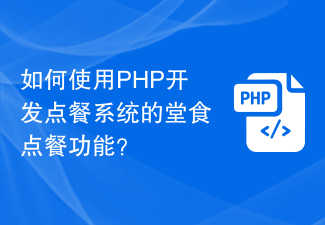 Backend Development
Backend Development Golang
Golang Implementation method of menu management function in food ordering system developed with Go language
Implementation method of menu management function in food ordering system developed with Go language
In recent years, with the development of mobile Internet, ordering systems have become more and more popular in the catering industry. In order to improve customer experience and reduce human resources, the menu management function of the ordering system is particularly important. In this article, we will introduce how to use Go language to implement menu management functions and provide detailed code examples.
1. Requirements analysis of menu management function
Before implementing the menu management function, the requirements first need to be analyzed. We need to determine the attributes of the menu based on the actual situation, including dish names, prices, pictures, descriptions, etc. In addition, the menu also needs to be classified and managed to facilitate users to find their favorite dishes.
1. Definition of dish attributes
When defining dish attributes, factors that need to be considered include dish name, price, picture, description, etc. We can use a structure to package these attributes, example The code is as follows:
type Dish struct {
Name string
Price float64
Image string
Description string
}- Menu classification definition
In order to facilitate user search, we need to classify and manage the dishes. Here, we can use Map to manage dish categories. The sample code is as follows:
type Menu struct {
Items map[string][]Dish
}In this structure, Items is a Map, where Key represents the category name and Value is the list of dishes.
2. Code implementation of menu management function
In the above demand analysis, we determined the definition of dish attributes and menu classification. Below we will introduce how to use Go language to implement these functions. .
1. Add new dishes
In the ordering system, the administrator needs to add new dishes to the menu. The following is an example function that can implement new functions of dishes:
func AddDish(item string, dish Dish, menu *Menu) {
if _, ok := menu.Items[item]; !ok {
menu.Items[item] = make([]Dish, 0)
}
menu.Items[item] = append(menu.Items[item], dish)
}In this function, we first determine whether the category exists, and if not, create a new category. Add new items to the menu.
2. Dishes update
In the ordering system, the administrator needs to update the dishes. The following is an example function that can implement the update function of dishes:
func UpdateDish(item string, dish Dish, menu *Menu) bool {
dishes, ok := menu.Items[item]
if !ok {
return false
}
for i, d := range dishes {
if d.Name == dish.Name {
dishes[i] = dish
return true
}
}
return false
}In this function, we first search for the dish with the same name as the incoming dish from the Map. If found, update the dish attributes and price, and return true, otherwise false is returned.
3. Delete dishes
In the ordering system, the administrator needs to delete dishes. The following is an example function that can implement the dish deletion function:
func DeleteDish(item string, dishName string, menu *Menu) bool {
dishes, ok := menu.Items[item]
if !ok {
return false
}
for i, dish := range dishes {
if dish.Name == dishName {
menu.Items[item] = append(dishes[:i], dishes[i+1:]...)
return true
}
}
return false
}In this function, we first search the Map for the dish with the same name as the incoming dish. If found, delete the dish from the list and return true, otherwise false is returned.
4. Dishes Query
In the ordering system, users need to query the dishes in the menu. The following is an example function that can implement the query function:
func FindDish(item string, dishName string, menu *Menu) *Dish {
dishes, ok := menu.Items[item]
if !ok {
return nil
}
for _, dish := range dishes {
if dish.Name == dishName {
return &dish
}
}
return nil
}In this function, we first search for the dish with the same name as the passed-in dish from the Map. If found, return the pointer of the dish, otherwise return nil .
3. Summary
This article introduces how to use Go language to implement the menu management function. Before implementation, we conducted a demand analysis and determined the definition of dish attributes and menu classification. Then, use structures and Maps to implement the functions of adding, updating, deleting and querying dishes.
It is worth noting that in actual development, we need to carry out more detailed design according to business needs to ensure that the menu management function is more complete and stable. At the same time, we also need to conduct detailed testing and optimization to improve system performance and user experience.
The above is the detailed content of Implementation method of menu management function in food ordering system developed with Go language. For more information, please follow other related articles on the PHP Chinese website!
 如何利用Go语言开发点餐系统的会员管理功能Nov 01, 2023 am 09:41 AM
如何利用Go语言开发点餐系统的会员管理功能Nov 01, 2023 am 09:41 AM如何利用Go语言开发点餐系统的会员管理功能一、引言随着移动互联网的普及,点餐系统成为了餐饮行业不可或缺的一部分。而会员管理功能作为点餐系统的重要组成部分,对于提升用户体验、增强用户黏性具有重要作用。本文将介绍如何利用Go语言开发点餐系统的会员管理功能,并提供具体的代码示例。二、会员管理功能的需求分析会员注册:用户可以通过手机号、邮箱等方式注册成为会员。会员登
 MySQL 实现点餐系统的库存盘点功能Nov 01, 2023 am 10:21 AM
MySQL 实现点餐系统的库存盘点功能Nov 01, 2023 am 10:21 AMMySQL实现点餐系统的库存盘点功能随着餐饮行业的不断发展,一种有效、高效的点餐系统已经成为餐厅经营的必要条件。而针对点餐系统的库存盘点功能的实现,MySQL数据库是一种非常方便和高效的选择。本文将介绍如何在MySQL数据库中实现点餐系统的库存盘点功能,以及具体的代码示例。一、数据库设计在MySQL中,库存盘点功能需要设计以下几个数据库表:商品表
 如何利用Go语言开发点餐系统的支付管理功能Nov 01, 2023 am 11:28 AM
如何利用Go语言开发点餐系统的支付管理功能Nov 01, 2023 am 11:28 AM如何利用Go语言开发点餐系统的支付管理功能随着移动支付的普及,点餐系统已经成为餐饮行业中不可或缺的一部分。为了提高用户体验和效率,很多餐厅开始使用点餐系统,而开发者也在不断寻找更好的技术方案来满足不断变化的需求。本文将介绍如何利用Go语言开发点餐系统的支付管理功能,并给出相应的代码示例。一、设计支付管理功能在设计支付管理功能前,我们要明确点餐系统需要支持的支
 如何利用Go语言开发点餐系统的打印小票功能Nov 01, 2023 am 08:08 AM
如何利用Go语言开发点餐系统的打印小票功能Nov 01, 2023 am 08:08 AM如下是一篇有关如何利用Go语言开发点餐系统的打印小票功能的文章:标题:利用Go语言开发点餐系统的打印小票功能随着社会的发展和人们对便利的需求不断增加,点餐系统成为了餐饮行业中的重要一环。而对于餐厅来说,打印小票是点餐系统中的一个关键功能。本文将介绍如何利用Go语言开发一个简单而高效的点餐系统,着重讲解其中的打印小票功能,并给出具体的代码示例。一、点餐系统概述
 如何使用Java开发点餐系统的菜单管理功能Nov 01, 2023 pm 03:08 PM
如何使用Java开发点餐系统的菜单管理功能Nov 01, 2023 pm 03:08 PM如何使用Java开发点餐系统的菜单管理功能随着餐饮行业的发展,点餐系统已经成为餐厅的必备工具之一。而菜单管理功能是点餐系统的重要组成部分之一,它能够帮助餐厅更好地管理菜单信息,提供给顾客清晰明了的菜单信息,并且实现快速准确的点餐服务。本文将介绍如何使用Java开发点餐系统的菜单管理功能。一、需求分析在开始开发之前,我们首先要明确点餐系统菜单管理的具体需求,以
 如何使用PHP开发点餐系统的堂食点餐功能?Nov 01, 2023 am 10:04 AM
如何使用PHP开发点餐系统的堂食点餐功能?Nov 01, 2023 am 10:04 AM点餐系统是在快餐餐厅、餐馆等餐饮场所中广泛应用的一种系统,可以提高效率、减少误单、方便顾客、提高餐厅形象等。PHP是一种广泛使用的服务器端脚本语言,使用PHP开发点餐系统可以提高系统的稳定性、可扩展性和安全性。本文介绍如何使用PHP开发点餐系统的堂食点餐功能。一、概述堂食点餐是指顾客在餐厅内用餐时,将菜品点单后,由服务员记录,并将菜品信息传递给后厨,后厨根据
 如何通过PHP编写一个简单的在线点餐系统Sep 24, 2023 pm 04:26 PM
如何通过PHP编写一个简单的在线点餐系统Sep 24, 2023 pm 04:26 PM如何通过PHP编写一个简单的在线点餐系统互联网的发展带来了许多便利,其中之一就是在线点餐系统。无论是快餐店还是餐馆,都可以通过在线点餐系统提供更好的服务。本文将介绍如何通过PHP编写一个简单的在线点餐系统,并提供具体的代码示例。一、系统需求分析在开始编写代码之前,我们需要先进行系统需求分析,确定系统的功能和流程。一个简单的在线点餐系统应该包含以下几个模块:用
 如何为WordPress插件添加微信公众号菜单管理功能Sep 05, 2023 pm 05:55 PM
如何为WordPress插件添加微信公众号菜单管理功能Sep 05, 2023 pm 05:55 PM如何为WordPress插件添加微信公众号菜单管理功能随着微信公众号的快速发展,越来越多的人选择在WordPress上搭建自己的博客或网站。在WordPress插件的世界里,也有许多强大的插件可供选择,但有时候我们可能需要为插件添加一些特定的功能。本文将介绍如何为WordPress插件添加微信公众号菜单管理功能,并附上相应的代码示例。在开始之前,我们需要明确


Hot AI Tools

Undresser.AI Undress
AI-powered app for creating realistic nude photos

AI Clothes Remover
Online AI tool for removing clothes from photos.

Undress AI Tool
Undress images for free

Clothoff.io
AI clothes remover

AI Hentai Generator
Generate AI Hentai for free.

Hot Article

Hot Tools

EditPlus Chinese cracked version
Small size, syntax highlighting, does not support code prompt function

MinGW - Minimalist GNU for Windows
This project is in the process of being migrated to osdn.net/projects/mingw, you can continue to follow us there. MinGW: A native Windows port of the GNU Compiler Collection (GCC), freely distributable import libraries and header files for building native Windows applications; includes extensions to the MSVC runtime to support C99 functionality. All MinGW software can run on 64-bit Windows platforms.

SublimeText3 Chinese version
Chinese version, very easy to use

PhpStorm Mac version
The latest (2018.2.1) professional PHP integrated development tool

SublimeText3 Linux new version
SublimeText3 Linux latest version




